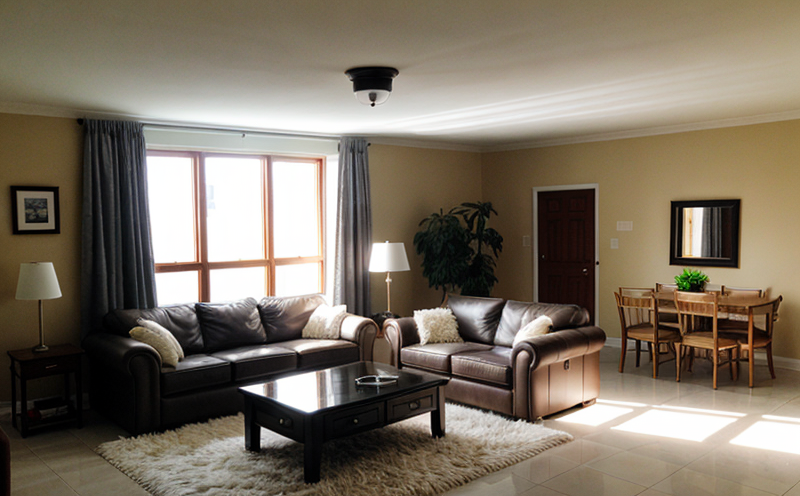IEC 61000 4 11 Voltage Dip and Interruption Testing for Indoor Lighting
The IEC 61000-4-11 standard is a critical tool in the quality assurance of indoor lighting systems. It provides comprehensive guidelines to evaluate how electrical devices, including lamps and luminaires, behave during voltage dips and interruptions. These events are common occurrences in power supply networks that can lead to significant performance degradation or even failure of sensitive electronic components.
In an era where energy efficiency is paramount, understanding the impact of voltage variations on lighting systems becomes increasingly important. This standard ensures that indoor lighting fixtures meet stringent requirements for reliability under adverse conditions. Compliance with IEC 61000-4-11 not only enhances product quality but also fosters confidence among consumers and stakeholders regarding system robustness.
The testing process involves subjecting the target device to a series of controlled voltage dips and interruptions, simulating real-world scenarios where power fluctuations might occur. By doing so, engineers can assess various aspects such as flicker levels, light output stability, and overall performance during these transient conditions.
For instance, when performing IEC 61000-4-11 testing on LED lamps, one must consider the effect of voltage dips on color rendering index (CRI). A sudden drop in voltage could cause temporary changes in perceived colors, impacting user experience. Similarly, interruptions lasting longer than specified limits may result in complete loss of light output, which is unacceptable for any application requiring continuous illumination.
In addition to these visual effects, other performance metrics like power factor and total harmonic distortion are also evaluated during testing. These parameters contribute significantly towards determining the energy efficiency rating of a lighting fixture. Ensuring compliance with IEC 61000-4-11 helps manufacturers design products that meet both regulatory requirements and consumer expectations.
Given its importance in maintaining high standards across various industries, it is essential for organizations involved in manufacturing or supplying indoor lighting solutions to have access to reliable testing facilities capable of conducting IEC 61000-4-11 voltage dip and interruption tests. Such services provide peace of mind by confirming that your products will perform consistently well even under challenging electrical environments.
Our laboratory offers state-of-the-art equipment tailored specifically for executing these types of tests according to international standards like IEC 61000-4-11. Our experienced team ensures accurate and repeatable results, providing valuable insights into your product's resilience against voltage dips and interruptions.
Quality and Reliability Assurance
- Voltage Dip Testing: This involves simulating a sudden reduction in supply voltage to observe the device’s behavior. The duration, depth, frequency, and recovery time of these dips are crucial parameters.
- Interruption Testing: Here, power is abruptly cut off for specified durations to assess how quickly and effectively the device recovers from such interruptions.
Both tests help identify potential weaknesses in design or manufacturing processes that could affect long-term reliability. Regular testing ensures continuous improvement of product quality by highlighting areas needing attention before they become critical issues during end-user applications.
| Dip Depth (%) | Dip Duration (ms) | Recovery Time (s) |
|---|---|---|
| -10 to -30 | 5-200 | 0.5-60 |
| -15 to -40 | 10-100 | 1-30 |
| -20 to -50 | 20-80 | 2-15 |
The table above outlines typical ranges used in IEC 61000-4-11 testing. However, specific values may vary depending on the type of lighting being tested and its intended application.
International Acceptance and Recognition
The International Electrotechnical Commission (IEC) 61000 series addresses issues related to electromagnetic compatibility, including those concerning voltage dips and interruptions. These standards have gained widespread acceptance globally due to their rigorous approach towards ensuring robustness in electrical systems.
Many countries incorporate IEC requirements into national regulations, making compliance with these international standards a prerequisite for market entry or certification purposes. For instance, European Union directives often reference specific sections of the IEC 61000 series when specifying allowable limits on voltage variations and their durations.
By adhering to IEC 61000-4-11 guidelines during product development, manufacturers demonstrate commitment to producing reliable products that can withstand typical power quality challenges faced by users worldwide. This approach enhances brand reputation while reducing risks associated with non-conformance penalties or recalls.
Use Cases and Application Examples
- Commercial Buildings: Ensuring that indoor lighting systems maintain their performance during power outages or momentary voltage drops is crucial for maintaining operational continuity in office spaces, retail environments, and other commercial settings.
- Hospitals: Critical care areas require uninterrupted illumination. Testing according to IEC 61000-4-11 ensures that lighting systems remain functional even during brief disruptions.
- Data Centers: Reliable power supply is vital for data center operations. By testing indoor lighting against this standard, organizations can guarantee minimal disruption in critical infrastructure.
In each of these scenarios, the ability to withstand voltage dips and interruptions directly impacts user safety, operational efficiency, and overall satisfaction. Therefore, incorporating IEC 61000-4-11 into your quality assurance protocols is advisable for all applications involving indoor lighting systems.





